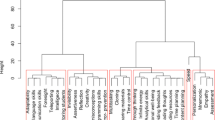Abstract
Analyzing the way computer technologies are used is crucial for their development. Such analyses make it possible to evaluate these technologies and enhance their evolution. The present article presents some ideas drawn from the development of a cooperation platform for elementary school children (10–11 years old). On the basis of an obvious ergonomic requirement, we worked on two other dimensions: cultural aspects and the teaching scenario. The goal was to set up observation situations and analyze the conversations produced during those situations, in order to understand what using the platform meant to both the pupils and their teachers.







Similar content being viewed by others
Notes
Coopera is a RIAM project (Network for Multimedia and Audiovisual Innovation) financed by the Centre National du Cinema (French National Center for Cinema), 2002–2004.
http://www.cvshome.org/docs/manual/
For reasons of language comprehension, we have chosen to translate the sequence in English, even if this process poses some problems.
References
Bastien C, Scapin D (1993) Ergonomic criteria for the evaluation of human–computer interfaces. Institut National de Recherche en Informatique et en Automatique, Paris
Brassac Ch, Grégori N (2001) Situated and distributed design of a computer teaching device. Int. J Des Sci Technol 8(2):11–31
Crabtree A (1998) Ethnography in participatory design. Proceedings of the participatory design Conference, Seattle, WA, 12–14 November, pp 93–105
Dourish P (2003) The appropriation of interactive technologies: some lessons from placeless documents. Comput Support Coop Work 12:465–490
Dourish P (1995) Parting of the ways: divergence, data management and collaborative Work. In: ECSCW’95
Dourish P, Bellotti V (1992) Awareness and coordination in shared workspaces. In: CSCW’92
Feiler PH, Downey GF (1990) Transaction-oriented configuration management: a case study. CMU/SEI-90-TR-23 ESD-90/TR-224
Godart C, Rabhi F, Oster G, Skaf-Molli H, Perrin O, Molli P, Ray P (2004) The ToxicFarm integrated cooperation framework for virtual teams. Distrib Parallel Databases 15(1): 67–88
Gutwin C, Roseman M, Greenberg S (1996) A usability study of awareness widgets in a shared workspace groupware system. In: CSCW’96
Hutchins E (1995) Cognition in the wild. MIT Press, Cambridge
Kaptelinin V, Nardi B (2003) Post-cognitivist hci: second wave theories (panel report). In: CHI 2003, Ft. Lauderdale, FL, 5–10 April
Kuuti K, Bannon LJ (1993) Searching for unity among diversity: exploring the “interface” concept. In: Proceedings of INTERCHI’93, 24–29 April, pp 263–268
Levinson S (1983) Pragmatics. Cambridge University Press, Cambridge
Nardi B, Gilbert N, Mantei M, McCarthy J (1993) Mixing oil and water? Ethnography versus experimental psychology in the study of computer-mediated communication. In: Proceedings of INTERCHI’93, 24–29 April, pp 3–6
Searle JR, Vanderveken D (1985) Foundations of illocutionary logic. Cambridge University Press, Cambridge
Suchman L (1987) Plans and situated actions. The problem of man–machine cooperation. Cambridge University Press, Cambridge
Trognon A, Brassac C (1995) Formalizing the theory of intentionality. J Pragmatics 23:555–562
Vanderveken D (1990) On the unification of speech-acts theory and formal semantics. In: Cohen P, Pollack M, Morgan J (eds) Intentions in communication. MIT Press, Cambridge
Vinck D, Jeantet A (1995) Mediating and commissioning objects in the sociotechnical process of product design: a conceptual approach. In: MacLean D, Saviotti P, Vinck D (eds) Management and new technology: design, networks and strategies. COST Social Sciences Serie, Bruxelles, pp 111–129
Vygotsky LS (1978) Mind in society: the development of higher psychological processes. Harvard University Press, Cambridge
Acknowledgments
Many thanks to Jeriko, our industrial partner, Pascal Pierre, IT advisor for our regional school council, and of course to the teachers, directors, children in the schools who agreed to contribute to these experiments (Louis-Pergaud, Laxou, Jules Ferry and St Pierre, Nancy, and La Sapinière, Toul), and to Didier Paquelin who worked with us at the University of Bordeaux 3.
Author information
Authors and Affiliations
Corresponding author
Rights and permissions
About this article
Cite this article
Grégori, N., Hautecouverture, JC., Charoy, F. et al. Combining ergonomics, culture and scenario for the design of a cooperation platform. AI & Soc 20, 384–402 (2006). https://doi.org/10.1007/s00146-005-0025-2
Received:
Accepted:
Published:
Issue Date:
DOI: https://doi.org/10.1007/s00146-005-0025-2



